L&S
Learning
Support
Services
presents
TEACHING with TECHNOLOGY
ONLINE WORKSHOP SERIES | 2012-2013
Introduction to Blended Learning
Week 1 Objectives
- Define blended learning
- Survey various models of blended learning
- Identify opportunities and benefits to a blended learning approach
- Start to consider feasible pedagogical approaches for blended learning
 Observe & Consider
Observe & Consider
What is Blended Learning?
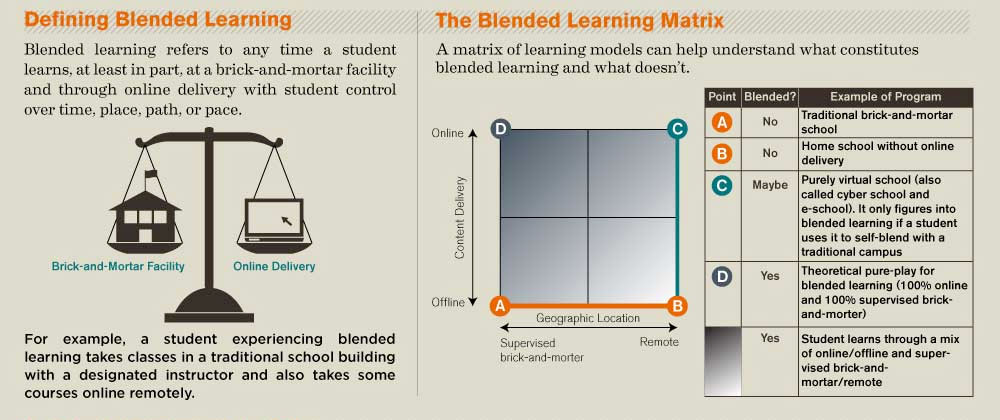
We hope to explore definitions of blended learning together as the week continues, but to get us started on this journey, here are a few thoughts we've gathered in pulling together resources in preparation for the course. Blended learning is a course design approach that fundamentally restructures class hours and the course environment by integrating face-to-face and online interaction. Blended learning leverages the strengths of online and face-to-face interactions to promote student engagement and help achieve the learning goals of the course. The blended learning course design process focuses on:
- Developing a conscious, pre-planned, and streamlined blended course plan unique for your course
- Questioning what is necessary to do in the classroom and how face-to-face hours are best used
- Thinking outside the box of both the traditional in-class lecture and only online-based learning
- Redesigning based on learning goals and expected student outcomes, rather than content
- Focusing on active student learning and collaboration
- Sustaining an engaged classroom community beyond the confines of a traditional classroom
 Share & Connect
Share & Connect
Discussion Activity
While some of us have been part of this online workshop series before, others of us are joining for the first time. Please take a moment to briefly introduce yourself. Provide your name, department, and interest/goals for this session on blended learning. If you have previous experience with blended learning, please share!
Word Association Activity
What words come to mind when you hear "blended learning"? List any and all below, and we will collect these into a word cloud to show our collective word associations with blended learning!
Blended Learning Definitions
 Observe & Consider
Observe & Consider
Defining Blended Learning
As we've seen in the previous section, blended learning can be defined in many ways. While a precise definition can be helpful, it is also helpful to simply consider the numerous interpretations of what blended learning can be and then work to define it for ourselves with our own context in mind. This idea is similarly true as we look at models of blended learning in the next segment of Week 1.
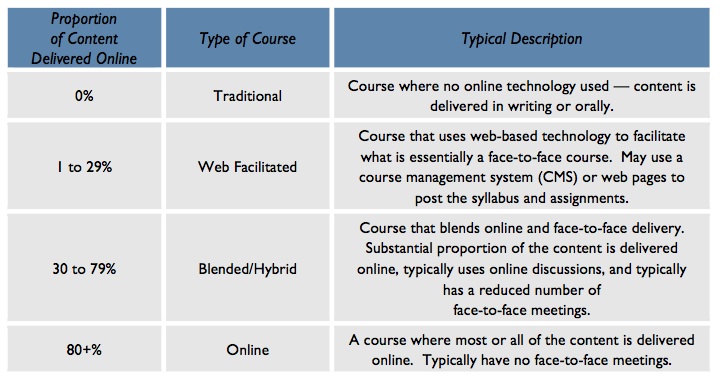
Foundations
Erin McCloskey, Director of Curriculum, Distance Education Professional Development at the UW Division of Continuing Studies, describes key concepts and provides fundamental background information regarding distinctions between online and blended learning.
Readings
Let's take a look at a few readings that help to define further what blending learning is and some key blended learning principles. Many of these readings also touch on strategies, challenges, and instructional design for blended learning, all topics that we will be discussing in the upcoming Weeks 2-4 of this session. (If you can only read one or two of these, we'd suggest the first two; they provide a short but comprehensive overview of blended learning fundamentals.)
- Blended Learning in Higher Education - Introduction of book - D. Randy Garrison & Norman D. Vaughn
- Hybrid Classrooms - The Chronicle of Higher Education
- Blended Learning: Uncovering its transformation potential in higher education - D. Randy Garrison & Heather Kannuka
- Blended Learning Systems: Definition, Current Trends, and Future Directions - Charles Graham
 Share & Connect
Share & Connect
Blended Learning Definitions
As we mentioned in the introduction to blended learning, there are many definitions of blended learning. In this activity we're going to explore variations blended learning by seeking out unique definitions. Here's how we'll do it:
- Search the web for resources that define or characterize blended learning in whole OR in part.
- Choose a few definitions or characteristics that resonate with you. Variety is key to the success of this exercise.
- Post the definition(s) or characteristic(s) to the wiki page here: Blended Learning Definitions Wiki.
- Read and consider the definitions posted by other participants.
Next week, we'll take this exercise one step further!
Blended Learning Models & Examples
 Observe & Consider
Observe & Consider
In the following podcast, Ron Cramer from DoIT Academic Technology leads a discussion about blended learning on campus. Listen as Ron talks with Jonathan, Chad, and Theresa about blended learning definitions and models:
Download the .mp3 (right-click and 'save link as')
 Observe & Consider
Observe & Consider
The Three Primary Models of Blended Learning
Supplemental
The supplemental model of blended learning leverages online course components to help enrich the face-to-face classroom. In the supplemental model, there is typically no real reduction in classroom meeting time. However, the online course components are thoughtfully planned to compliment classroom activities and extend learning beyond the classroom. The supplemental approach can take many forms and serve many different instructional goals. Here are just a few:
- Deepen interaction: Enable online collaboration to deepen classroom interactions.
- Increase time efficiency: Demonstrate key concepts or foundational material online to make better use of class time.
- Offer flexibility: On-demand review learning when they enter the classroom.
- Enable review and repetition: Use online modules to cover complex topics for students to access on demand.
One common challenge associated with this model of blended learning is avoiding the "course and a half" dilemma. Because seat time is not reduced and online components are added, the amount of additional material can significantly add to the overall workload for students.
Consider the UW-Madison "Flexible Physics in the Google World" project as an example of a supplemental approach. The project involved developing short and informative videos to help orient students to lab scenarios and more quickly get them started exploring concepts. View the sample video below and find more information at the flexible physics at UW-Madison website.
Emporium
The emporium model of blended learning replaces all or some traditional face-to-face class meetings with collaborative, activity-based work done in a learning resource center or a shared student learning space where students access the online course materials. A space like this typically offers lots of connectivity--computers, wireless connections, easy access to all online course materials, flexible furniture, etc.--and fosters collaborative learning in its space design. In transplanting the class meetings to this type of space, the emporium model's learning goals can include:
- Encouraging independent student work (often with either instructor or other in-person support is available in the emporium learning space)
- Allowing flexibility of class time: The learning process can be more fluid and allow for multiple "classes" to be held at the same time in one space
- Fostering collaboration and activity-based learning amongst students
- Making better use of shared spaces to enhance student learning and to rethink the efficacy of the traditional lecture-style course
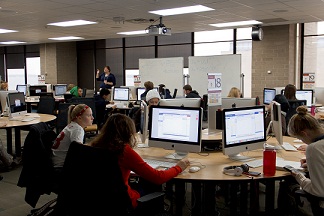
We have many examples of emporium spaces at UW-Madison, such as various active learning classrooms around campus and especially the WisCEL spaces in College Library and Wendt Commons.
Read about some of the details of various UW-Madison emporium-style spaces and the blended learning initiatives that are happening in these spaces:
- From L&S News and Notes: Doing the math: Department uses blended teaching approach
- The Wisconsin Collaboratory for Enhanced Learning (WisCEL)
- Wendt Commons & Engineering: Learning in libraries: New center marries instructional and study space
Replacement
The replacement model of blended learning substitutes online content and activities for portions of in-class class time and reduce face-to-face class time. The replacement model also changes the way that the face-to-face class time is structured: class time is dedicated more to interactive activities and peer-to-peer or student-to-instructor collaboration that cannot be conducted as easily online. The replacement model of blended learning is perhaps one of the more widely used and promoted models for blended learning course design, partly because it:
- Helps to mediate the "course and a half" syndrome of some of the other models by focusing on the reduction of in-class/seat time
- Often leverages an online micro-lecture style that makes efficient use of lecture materials and online lecture delivery
- Promotes efficiency of both in-class and online time
- Engages students with the course content in both the face-to-face and the online environments
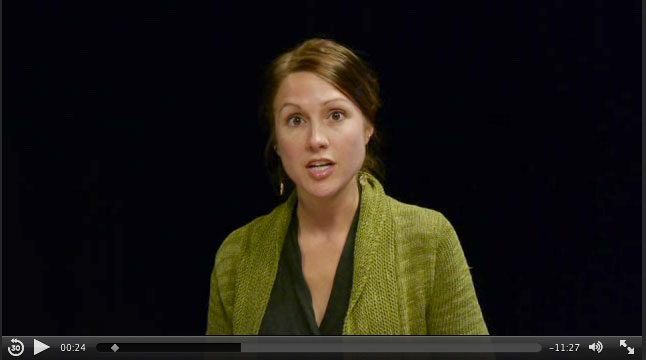
At L&S Learning Support Services, we've had the opportunity to support a blended learning course that employs the replacement mode. Social Work 644, taught by professor Don Anderson, originated as a "tele-course" that featured video recorded lectures were recorded and broadcast via Wisconsin Public Television. As the course evolved, the video lecture component was moved online. Now, students have an organized three-module progression that consists of numerous online activities and lecture videos that feature Professor Anderson and experts in various social work specialties relevant to the course. Because of the well developed online content and interactive learning activities, seat time is reduced to four times each semester (one orientation session and three discussion sections that correspond to each of the three modules). Because the online content is well developed, it is also used to offer continuing education for social work professionals throughout the state. It also serves as a helpful resource to a public facing audience as the lectures are useful to families who care for loved ones with a developmental disability. View their public website.
 Observe & Consider
Observe & Consider
Other Models of Blended Learning
Though these three models above are the most common models of blended learning in higher education, there exists a spectrum of blended learning models (some of which are more often used in K-12 environments). Take a look at the graphic below that describes the blended learning model spectrum. You'll notice that a few of these models overlap with one or more of the supplemental, emporium, or replacement models.
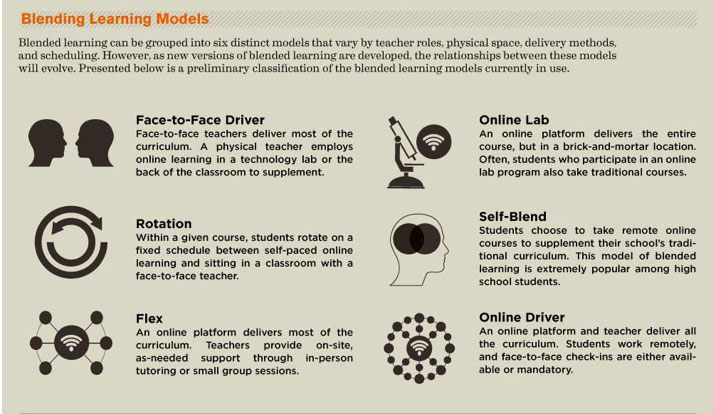
Flipped
The flipped classroom model is somewhat well known and often interchangeably used with blended learning, though it does not quite employ the same pedagogical approach as other blended learning models. For this reason, the flipped classroom is generally considered to be a step toward blended learning but not a true blended learning model. A flipped classroom can be somewhat narrowly characterized as course delivery approach that simply reverses the lecture and home paradigm - lectures are recorded and delivered online and homework is done during the regular class meeting time. While the flipped model significantly changes the way an instructor manages the course, the model might not fundamentally change the pedagogical approach of the course and engage with some of the key blended learning concepts (such as reduction in seat time, active student learning, and efficient use of in-class and online time).
That said, there are still benefits and opportunities for the students with the flipped classroom. First, the active portion of their learning is done in close proximity to the instructor during the in-class session. Second, the lecture recordings can be available on demand and can be played and replayed to help absorb complex topics or review in advance of an assessment. Finally, the approach opens possibilities for peer-to-peer learning and collaboration among students to help build a vibrant learning community. Developing a flipped classroom module can also help instructor move toward creating a more fully realized blended learning environment.
Read more about the flipped classroom and its use: Educause's "7 Things You Should Know About the Flipped Classroom"
HyFlex
The hyflex model is popular in K-12 education and is a hybrid of many of the other blended learning models. Effectively, the hyflex model is a "blended" blended learning model, meaning that the students can choose their method of delivery (in-class or online) for various activities and course content and have multiple modes of delivery to choose from per course module/assignment/activity.
Read more about the hyflex model and its use: Educause's "7 Things You Should Know About the HyFlex Course Model"
Week 1 Closing & Checklist
End of Week 1
Thanks for completing Week 1 with us! In this week of our Blended Learning online workshop session, we:
- Defined blended learning
- Surveyed various models of blended learning
- Identified opportunities and benefits to various blended learning models
- Started to consider feasible pedagogical approaches for blended learning
Upcoming for Week 2
In Week 2 of this session, we will:
- Survey various blended learning design approaches
- Consider various benefits and challenges of blended learning course design and ways of navigating this design process
- Identify the reciprocal action between face-to-face and online environments in a blended course
- Reassess traditional face-to-face course assessment, instructor-student relationships, and student learning for a blended learning environment